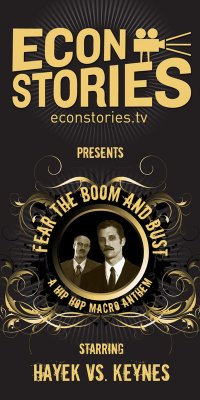Fear the Boom and Bust
A Hayek vs. Keynes Rap Anthem
Creative director: John Papola
Creative economist: Russ Roberts
Cast:
- Billy Scafuri — John Maynard Keynes
- Adam Lustick — Friedrich A. Hayek
Econ Stories: 2010
The economists speak — and sing
 Even more than most academic fields, economics has a reputation for dullness; one of its nicknames is "the dismal science". It was a surprise, probably even for its creators, when Fear the Boom and Bust, a video about the causes of depressions and the policies needed to correct them released on YouTube, became an almost instant hit, viewed over a million times in less than three months:
Even more than most academic fields, economics has a reputation for dullness; one of its nicknames is "the dismal science". It was a surprise, probably even for its creators, when Fear the Boom and Bust, a video about the causes of depressions and the policies needed to correct them released on YouTube, became an almost instant hit, viewed over a million times in less than three months:
Fear the Boom and Bust
A Hayek vs. Keynes Rap Anthem
created by John Papola and Russ Roberts
It's formatted as a rap video, with John Maynard Keynes and Friedrich Hayek, returned from the dead, presenting their conflicting theories. Keynes was probably the Twentieth Century's best known economist, and an advocate of government control of the economy, through a central banking system, to keep capitalist economies prosperous. Hayek was much less widely known, despite his 1974 Nobel Memorial Prize in economics; along with Joseph Schumpeter and Ludwig von Mises, he was one of the leading figures in the non-mainstream Austrian school, which tends to look on any government intervention as neither effective nor safe. The two men actually did know each other, and debated the proper response to the Great Depression in the 1930s, though Keynes's ideas eventually won out. Reflecting this, the opening scene has them checking into a conference hotel, when the receptionist instantly fawns over Keynes but has to have Hayek's name spelled for her.
Fitting economic theories into lyrics has to have been a challenge, but this piece does it amazingly well. The refrain sums up the basic clash:
Hayek & Keynes: We've been going back and forth for a century
Keynes: I want to steer markets
Hayek: I want them set free
Hayek & Keynes: There's a boom and bust cycle and good reason to fear it
Hayek: Blame low interest rates
Keynes: No, it's the animal spirits
Then each man's ideas are summed up in two verses. Keynes emphasizes getting the economy out of the bust phase by applying the stimulus of government spending, funded if necessary by deficits and money creation; if consumers have income and are ready to spend it, demand will get businesses going again and create jobs. Hayek says that it's not the bust that Keynes should focus on, but the boom: artificially low interest rates and credit expansion encourage investments that can't be sustained over time, unless those that result from voluntary saving. "The boom plants the seeds for its future destruction." Both arguments are clear, and follow what the two men actually thought, in the terminology they actually used.
While this is going on, the viewer is getting a little story to frame the theory: Keynes invites Hayek out for a night on the town before their conference, with drinking, beautiful women, and a bit of gambling. The characterization is classic, with Keynes in the role of the alazon or boastful man, and Hayek as a critical eiron undermining his pretensions. Keynes parties as if there were no tomorrow ... repeating his famous saying, "In the long run, we're all dead." But he ends up vomiting half the night and then lying in bed desperately reaching for another drink, while Hayek takes the bottle away and tells him, "In the long run, my friend, it's your theory that's dead." The actions and the characterization in fact perfectly dramatize the ideas! Where Keynesians think that stimulating the economy makes for healthy growth, Austrians view booms as a kind of fever that burns up long-term resources, and think the key to health is an economic version of detox. This storyline suggests that the makers find the Austrian view more convincing ... but both sets of ideas are presented fairly.
This video probably gained some of its success from the current depression, which forces economics onto a lot of people's minds. There may be a bit more skepticism about Keynes's ideas this time than there was during the Great Depression; the damage done by people rushing to buy overpriced housing is all too visible. The popularity of Fear the Boom and Bust, like the increased sales of Atlas Shrugged, suggests that many people may be willing to look at alternatives to more government control. But a performance as witty as this deserves to live on after the crisis that may have inspired it.
© 2010 William H. Stoddard
Taking Hayek Seriously
See for instance:
Why The Road to Serfdom is a Bestseller ... Again
by Bruce Caldwell
W.H. Stoddard on
The Algebra of John Maynard Keynes
W.H. Stoddard's review of
Robert A. Heinlein: In Dialogue with His Century
Volume 1, 1907-1948: Learning Curve
More by William H. Stoddard
Coining at Troynovant
quantifying value into commodity;
true coin, false coin, enterprise & economics
Music at Troynovant
music, song, dance, & composers
Utopia at Troynovant
utopia in power, or dystopia
| Troynovant, or Renewing Troy: | New | Contents | |||
| recurrent inspiration | 200 Recent Updates | |||
|
www.Troynovant.com |
||||
|
Feature Films: Queen Mab's ride |
||||
| Strata | Regions | Personae |
|
|||